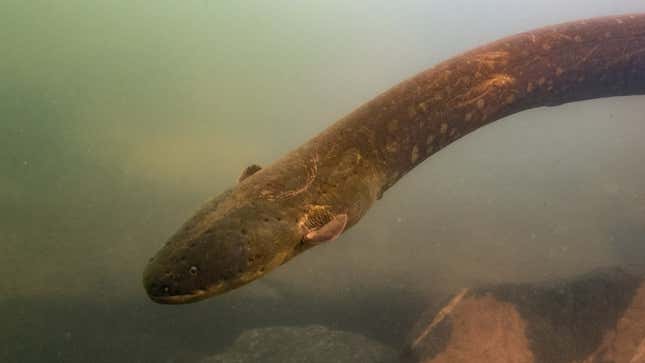
Electric eels were already exceptionally weird fish. These eels—actually three different species of giant, South American knifefish—pack as much as an 860-volt punch used to stupefy prey and defend themselves. Long thought to be exclusively solitary predators of slow, murky rivers, new research suggests electric eels can hunt in groups, cooperatively training their electric pulses on schools of prey fish.
The behavior is astonishingly similar to a wolf pack coordinating to take down a meal, but with fins and tasers. The discovery makes electric eels one of a handful of fish species known to hunt in groups, and the only one of these to jolt their prey into submission.
In 2012, Douglas Bastos—a scientist at Instituto Nacional de Pesquisas da Amazônia in Manaus, Brazil—traveled to the Iriri River in the Amazon basin to explore and sample the area’s diversity of fish life. There, he found a small, quiet lake connected to the river. Incredibly, he saw well over 100 electric eels gliding through the lake water. Bastos watched as the eels appeared to herd small tetra fish into a tight ball, with several eels periodically shocking the school in concert with each other. The tetras would erupt out of the water, with the eels snapping up whatever stunned, scaly morsels they could.

Carlos David de Santana—an ichthyologist at the Smithsonian’s National Museum of Natural History and senior author on the new study—said the observations were, well, “shocking” when he first heard of them.
“Historically, we don’t have any kind of information on electric eels living together,” de Santana told Gizmodo. “They were thought to live alone and maybe congregate before the breeding season, but that was it.”
Just hunting in a pack like this is extremely rare behavior for fish. There are tens of thousands of fish species, but only nine are known to hunt in groups like this, according to de Santana.
Curiously enough, one of these fish is an African species that also uses electrical fields to its advantage. However, those electric chisembe fish (Mormyrops anguilloides) are only using their superpowers to locate prey in nightly hunting parties, not using Zeus’s might to fry their lunch into the afterlife.
Bastos returned to the small lake in 2014 to collect more detailed observations on the eels, watching and filming them for three full days. Again, many dozens of eels were congregating in the lake, working together to herd and electrocute prey fish, showing that the 2012 chance observations weren’t a one-time occurrence.
These observations—published today in the journal Ecology and Evolution—reveal a rhythm to this collaborative effort. Most of the day, the eels rest in the deeper part of the lake. But in twilight, the eels would start swimming together, ominously wheeling in a big circle. This Hula Hoop of Death would meander over to the tetra schools, crowding them together and ushering them into the shallows. Then, several eels would volley a powerful discharge, giving the whole party a chance to gobble down their paralyzed prey. They’d go through several rounds more of this before breaking up to rest.
It’s unclear exactly why these particular electric eels are using this hunting strategy, since it’s never been reported outside of this one little lake. De Santana wonders if certain environmental conditions may make group hunting more likely. For instance, in the rainforest lowlands, the rivers are wide, with abundant fish to eat. But in the highlands where these eels were spotted, prey is more scarce.
“Solitary hunting behavior could be much harder to do [in the highlands],” said de Santana, noting that the fish might spend more energy trying to locate prey, making group hunting useful.
Whatever reason for the hunting strategy, the findings suggest that electric eels experience a social world that has gone undetected until now.

Michael Taborsky—a behavioral ecologist at the University of Bern who was not involved with this research—said the discovery “fits well into what we know already about group hunting behaviors in fish hunting animals,” noting that working together to catch fish is widespread among animals, if not among predatory fish.
He said the behavior reminds him of swordfish, which dart into dense schools of fish, slashing at fish with their sword snout to stun or kill them.
Taborsky said it’s not yet clear if there’s actually communication and coordination between the eels, even if they are moving synchronously. He’s also curious if these observations can be replicated elsewhere in the eel’s range.
“One can assume if [the group hunting] happens over and over again, that this is really a kind of selected response to the challenge of catching a grouping of prey items,” explained Taborsky.
Going forward, de Santana wants more detail on the coordination aspect of these group hunts, hypothesizing that the animals achieve their synchronized movements and discharges by communicating with their low voltage discharges, often used for navigating and solo foraging.
The group hunting was only seen in one of the three electric eel species—Electrophorus voltai—but de Santana thinks the other two species could also be doing this. He also wonders if hunting party members are a family group. Future genetic sampling could answer this.
Learning more about these zap-happy eel crews is, sadly, a race against time. De Santana said that special spots like the little lake—chock-full of prey and providing long-term shelter for animals—are increasingly rare in the Amazon in the wake of deforestation.